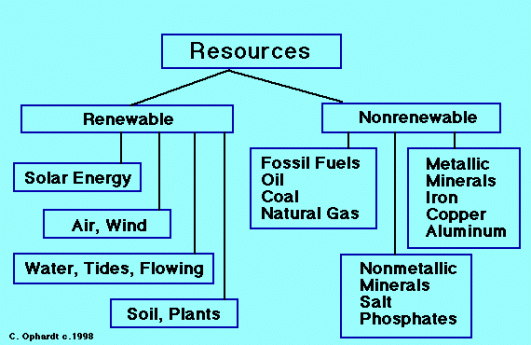Sounds like homework, so I'll guide you to resources (pun intended) rather than give the answer.

Or
http://study.com/academy/lesson/renewable-non-renewable-resources-definition-differences.html
Sounds like homework, so I'll guide you to resources (pun intended) rather than give the answer.

Or
http://study.com/academy/lesson/renewable-non-renewable-resources-definition-differences.html
Renewable Energy resources are those that will not run out, such as solar power, whereas non-renewable energy sources are those that only have a limited supply, such as fossil fuels. As a general rule, renewable energy sources are also sustainable, with no (or very little) carbon dioxide production, which is great for the environment.
Popular Renewable Energy Sources include:
Solar Power – Solar power works by harnessing the power of the sun to generate energy, commonly using solar panels. Solar panels come in two forms – solar thermal panels for heat production and solar photovoltaic panels, for electricity production.Hydroelectric Power – Hydroelectricity is created from flowing water, which is often diverted down large steep pipes to create speed and power before the water meets a turbine. The turbine spins, converting the energy in to electricity.
Wind Power – Wind turbines work in a similar fashion to hydroelectricity, but instead of water, they use wind to spin their turbines. Wind turbines can have fantastic electricity yields, particularly in places with constant wind.
Biomass Power – Biomass power involves unlocking the power stored within organic materials. In domestic settings, biomass boilers are becoming increasingly popular, which use wooden pellets to heat water. The carbon emissions for the burning is offset by the carbon absorbed by the plant during its life.Tidal Power – Another form of electricity created using water, however tidal power uses the oceans currents and tides to generate its electricity.
Geothermal Power – This involves creating power from the hot steam rising from the Earth’s hot inner crust, several miles below the surface. This steam spins turbines, which create electricity.Didn't find the answer you were looking for?